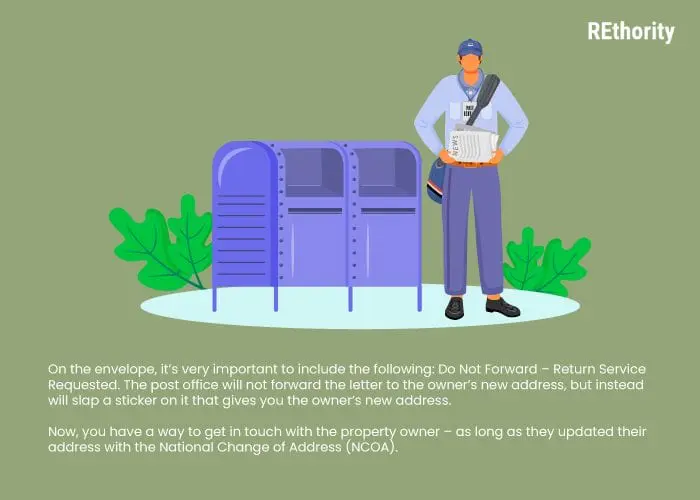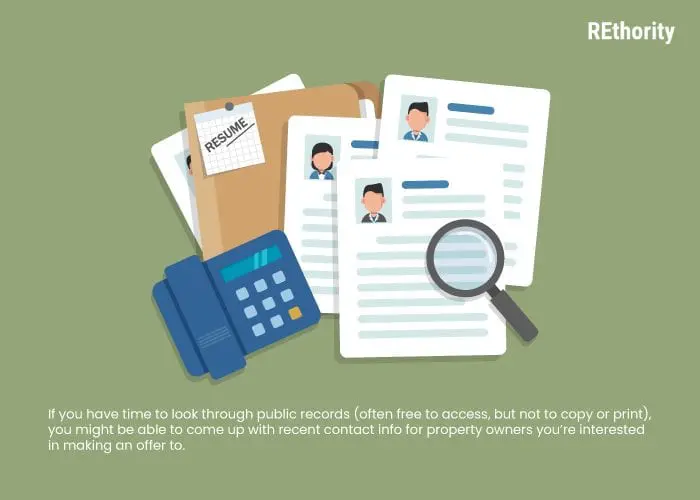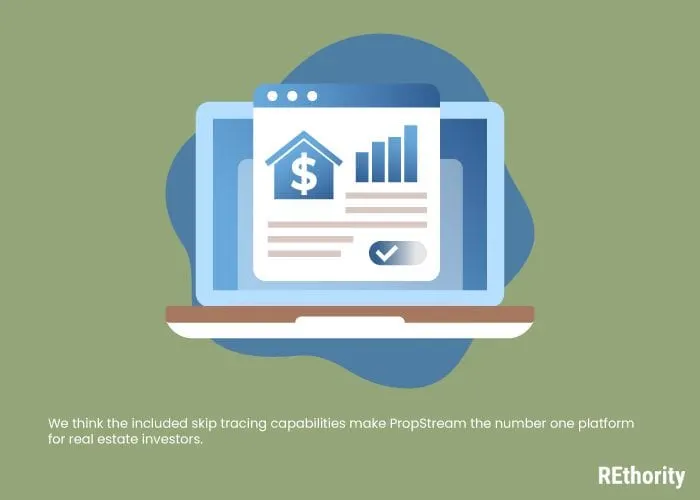Are you a real estate investor interested in skip tracing? If so, this guide is for you.
Read on to learn about one of the most effective ways to generate seller leads and how to maximize its impact.
Wondering About Skip Tracing?

Skip tracing is the key to finding untouched seller leads. Private investigators and law enforcement agencies also use this technique, but it’s even more beneficial for real estate investors.
Read our complete guide to skip tracing to learn how to locate the most elusive sellers. If finding good seller leads is getting harder, you might not be looking in the right place.
Advertising and using seller lead magnets can be effective, but every other real estate investor is using those same methods to generate seller leads, too.
How can you get a leg up on the competition when you’re using the same source for information? You’ll have to boldly go where few real estate investors have gone before to gain a competitive edge.
Enter, Skip Tracing
Skip tracing will be your secret weapon. Skip tracing is a little-used tactic that helps you access prime motivated seller leads that other investors haven’t been able to contact.
But this lead generation method is notoriously time-consuming. The trick is learning how to skip trace without investing too much time into it. That’s what our guide will explain in detail.
We’ll teach you the ins and outs of REI skip tracing, explain who can benefit from using it, and show you three effective methods to use it to find promising seller leads that haven’t been bombarded by other investors.
What Is Skip Tracing?

Skip tracing is most commonly associated with law enforcement, debt collection, and private investigation.
That’s because it’s a powerful sleuthing technique used to locate contact information for someone who isn’t easily found.
Skip tracing is typically used to find out the name, phone number, address, or other contact information of someone who has “skipped town” or just isn’t easy to locate.
It’s also used to find contact information for an unknown person who meets specific criteria. The act of skip tracing isn’t quite as exciting as it sounds.
The Reality
Usually, it’s just trudging through many public and private records to get clues to a person’s whereabouts. Why would a real estate investor use skip tracing to find seller leads if there are easier methods available?
Two things make skip tracing worth an investor’s time and attention. First, it provides access to property owners who are not likely to have been contacted yet by another investor.
These are not necessarily owners who have left town or are in hiding. Hard-to-find property owners aren’t fed up with phone calls, letters, and emails from investors because other investors haven’t been able to figure out who they are or how to contact them.
Second, skip tracing can be time-consuming if it’s done manually through public records, but it can be done with very little time investment if you know the right platforms to use. We’ll explain more about these platforms in a bit.
Who Uses Skip Tracing?
A few different professions utilize skip tracing. If you’re a bounty hunter, detective, or debt collector, you skip trace to find contact information.
This will be used to either bring the person into custody, provide information on their whereabouts to your client, or collect a debt.
But if you’re a real estate investor, you want this information so you can get in touch with the unicorn of the real estate investing world: a property owner who has never been contacted by another investor.
Why Investors Use Skip Tracing

Real estate investors use skip tracing to find unspoiled seller leads. But these leads are not just promising because they haven’t received offers from other investors. They’re also potentially highly motivated.
Property owners worthy of a little sleuthing may include those who:
- Own vacant or abandoned property
- Just became empty-nesters
- Recently inherited property
- Are behind on taxes or mortgage payments?
- Are in danger of foreclosure?
- Have more than 50% home equity
- Are incarcerated or in a long-term living facility
- Are getting married or divorced?
- I recently had a baby
These property owners all have good reasons to want to sell their property. And because they haven’t gotten offers from other investors, your offer has a better chance of being seriously considered and accepted.
In general, if it’s a challenge to find a property owner, most investors haven’t bothered to dig deeper. They’re more interested in the easily accessible, low-hanging fruit.
If they’ve sent a mailer and it was returned, or if they’ve called the last known number and it was disconnected, a huge majority will just give up on that lead.
This is known as taking the path of least resistance. Fortunately for you, hard-to-find property owners are ripe for the picking; you just have to know the right skip tracing techniques to get to them.
How to Use Skip Tracing to Find Seller Leads
You now know why skip tracing is such a valuable method for real estate investors. Next, let’s look at how to use skip tracing to get current contact information for hard-to-find seller leads.
1. United States Postal Service

One tried-and-true technique to get current contact information for someone is to get it from the United States Postal Service (USPS).
In general, the post office isn’t required to give you updated address information on someone who has moved unless you’re a law enforcement officer, a licensed investigator, or acting on court orders.
There is a clever way around that. What you can do is send a mailer or letter to the last known address of the property owner you’re seeking.
On the envelope, it’s very important to include the following: Do Not Forward: Return Service Requested.
The post office will not forward the letter to the owner’s new address, but instead will slap a sticker on it that gives you the owner’s new address.
Now, you have a way to get in touch with the property owner, as long as they update their address with the National Change of Address (NCOA).
2. Public Records

Public records may have the contact information you’re looking for. You’ll just have to do a lot of digging to find it. Reviewing public records is the most time-consuming method of skip tracing, but it is effective.
You can review the following public records to find contact information:
- Employment records
- State and local tax information
- DMV records
- Divorce records
- Court and criminal records
- Property and land records
- Building permits
- Internal Revenue Service records
- Utility records
- Licenses (business, marriage, professional, etc.)
A property owner might not have updated their address with the post office but was recently issued a building permit or business license at a new address. Maybe someone recently divorced or had a baby, which may indicate they’ll be willing to sell soon.
If you have time to look through public records (often free to access but not to copy or print), you might be able to come up with recent contact information for property owners you’re interested in making an offer to.
Real Estate Software

Far and away, using real estate software is the most effective and least time-consuming way to skip trace property owners.
Say you have a vacant property in mind but have no idea who owns it or how to get in touch with them.
Or maybe you’re looking for anyone who meets certain criteria, like recently inherited out-of-state property or having more than 50% equity in their home.
Using powerful real estate software enables you to instantly compile all the public information you need. For example, PropStream provides you with:
- Full name
- Email address
- Phone numbers
- Mailing address
- Associated public records
PropStream also allows you to automatically call the property owner and have your call go directly to their voicemail. This avoids breaking any robocalling laws and keeps you from wasting money on direct mailers with a lower response rate.
We think the included skip tracing capabilities make PropStream the number one platform for real estate investors.
In addition to complete skip tracing capabilities, investors can use the software to:
- Do unlimited property searches nationwide
- Export up to 10,000 monthly property data reports
- Build targeted property lists
- Generate and nurture seller leads
- Analyze potential investments and rehab costs
- Generate instant comps
- And much, much more
All PropStream users start with a free 7-day trial. And if you check out our review of the platform, you’ll find an exclusive promo. Sound interesting? Be sure to read our full product review.
Is Skip Tracing Worth Your Time?

Skip tracing helps you reach hard-to-find motivated sellers, but is it worth your time? We think so. Easily accessible seller leads attract a lot of competition from other investors.
Some investors think these are the most valuable leads because they spend less time finding them. However, the opposite is true.
It doesn’t matter how quickly you can find a seller lead if they’ve already accepted an offer from another investor who contacted them first.
Why We Love Skip Tracing
You might have to dedicate a little more time to skip trace seller leads, but you’ll likely be the first to contact them. That means they haven’t received other offers and will be more receptive to yours.
Skip tracing connects you with property owners who are in various circumstances that make them likely to sell.
Manually digging up information on hard to find leads through public records isn’t the best way to approach the situation, though. It’s too time-consuming, and in real estate investing, time is money.
However, if you use smart skip tracing methods, like PropStream’s automated platform, you’ll have an effective seller lead generation strategy that enables you to capture and convert more leads in less time.

